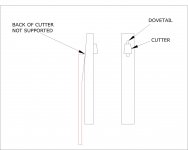Discrepancyform
Plastic
- Joined
- Aug 8, 2017
Having horrible tool life and trouble with the cutter getting sucked up in the material and either stalling the machine or exploding the cutter. More pressure on the cutter bar only seems to make it worse. Running about 18 sfm and .001-.002" a whack using a hydraulic mitts n Merrill that I've made 3" chips in 304 with. Cutter is m42 with 3° clearance and about that much positive rake (I think) Depending on the bore size and setup I can use, I'm roughing 3/4-1 1/4 to finish 1 1/4-2. Thinking about negative rake but worried about chatter.
Thanks
Thanks


